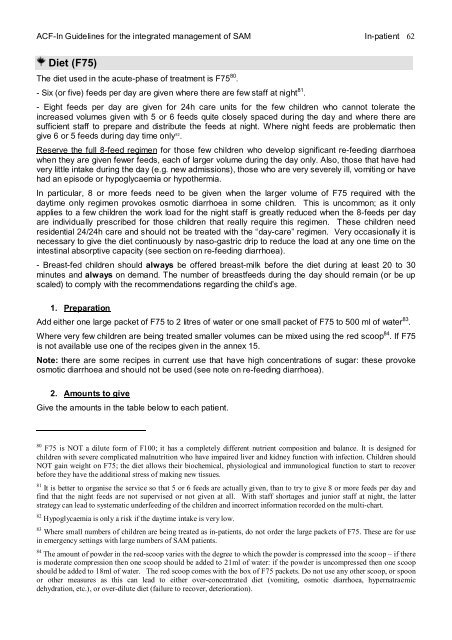guidelines for the integrated management of severe acute malnutrition
guidelines for the integrated management of severe acute malnutrition
guidelines for the integrated management of severe acute malnutrition
You also want an ePaper? Increase the reach of your titles
YUMPU automatically turns print PDFs into web optimized ePapers that Google loves.
ACF-In Guidelines <strong>for</strong> <strong>the</strong> <strong>integrated</strong> <strong>management</strong> <strong>of</strong> SAM In-patient 62<br />
Diet (F75)<br />
The diet used in <strong>the</strong> <strong>acute</strong>-phase <strong>of</strong> treatment is F75 80 .<br />
- Six (or five) feeds per day are given where <strong>the</strong>re are few staff at night 81 .<br />
- Eight feeds per day are given <strong>for</strong> 24h care units <strong>for</strong> <strong>the</strong> few children who cannot tolerate <strong>the</strong><br />
increased volumes given with 5 or 6 feeds quite closely spaced during <strong>the</strong> day and where <strong>the</strong>re are<br />
sufficient staff to prepare and distribute <strong>the</strong> feeds at night. Where night feeds are problematic <strong>the</strong>n<br />
give 6 or 5 feeds during day time only 82 .<br />
Reserve <strong>the</strong> full 8-feed regimen <strong>for</strong> those few children who develop significant re-feeding diarrhoea<br />
when <strong>the</strong>y are given fewer feeds, each <strong>of</strong> larger volume during <strong>the</strong> day only. Also, those that have had<br />
very little intake during <strong>the</strong> day (e.g. new admissions), those who are very <strong>severe</strong>ly ill, vomiting or have<br />
had an episode or hypoglycaemia or hypo<strong>the</strong>rmia.<br />
In particular, 8 or more feeds need to be given when <strong>the</strong> larger volume <strong>of</strong> F75 required with <strong>the</strong><br />
daytime only regimen provokes osmotic diarrhoea in some children. This is uncommon; as it only<br />
applies to a few children <strong>the</strong> work load <strong>for</strong> <strong>the</strong> night staff is greatly reduced when <strong>the</strong> 8-feeds per day<br />
are individually prescribed <strong>for</strong> those children that really require this regimen. These children need<br />
residential 24/24h care and should not be treated with <strong>the</strong> “day-care” regimen. Very occasionally it is<br />
necessary to give <strong>the</strong> diet continuously by naso-gastric drip to reduce <strong>the</strong> load at any one time on <strong>the</strong><br />
intestinal absorptive capacity (see section on re-feeding diarrhoea).<br />
- Breast-fed children should always be <strong>of</strong>fered breast-milk be<strong>for</strong>e <strong>the</strong> diet during at least 20 to 30<br />
minutes and always on demand. The number <strong>of</strong> breastfeeds during <strong>the</strong> day should remain (or be up<br />
scaled) to comply with <strong>the</strong> recommendations regarding <strong>the</strong> child’s age.<br />
1. Preparation<br />
Add ei<strong>the</strong>r one large packet <strong>of</strong> F75 to 2 litres <strong>of</strong> water or one small packet <strong>of</strong> F75 to 500 ml <strong>of</strong> water 83 .<br />
Where very few children are being treated smaller volumes can be mixed using <strong>the</strong> red scoop 84 . If F75<br />
is not available use one <strong>of</strong> <strong>the</strong> recipes given in <strong>the</strong> annex 15.<br />
Note: <strong>the</strong>re are some recipes in current use that have high concentrations <strong>of</strong> sugar: <strong>the</strong>se provoke<br />
osmotic diarrhoea and should not be used (see note on re-feeding diarrhoea).<br />
2. Amounts to give<br />
Give <strong>the</strong> amounts in <strong>the</strong> table below to each patient.<br />
80 F75 is NOT a dilute <strong>for</strong>m <strong>of</strong> F100; it has a completely different nutrient composition and balance. It is designed <strong>for</strong><br />
children with <strong>severe</strong> complicated <strong>malnutrition</strong> who have impaired liver and kidney function with infection. Children should<br />
NOT gain weight on F75; <strong>the</strong> diet allows <strong>the</strong>ir biochemical, physiological and immunological function to start to recover<br />
be<strong>for</strong>e <strong>the</strong>y have <strong>the</strong> additional stress <strong>of</strong> making new tissues.<br />
81 It is better to organise <strong>the</strong> service so that 5 or 6 feeds are actually given, than to try to give 8 or more feeds per day and<br />
find that <strong>the</strong> night feeds are not supervised or not given at all. With staff shortages and junior staff at night, <strong>the</strong> latter<br />
strategy can lead to systematic underfeeding <strong>of</strong> <strong>the</strong> children and incorrect in<strong>for</strong>mation recorded on <strong>the</strong> multi-chart.<br />
82 Hypoglycaemia is only a risk if <strong>the</strong> daytime intake is very low.<br />
83 Where small numbers <strong>of</strong> children are being treated as in-patients, do not order <strong>the</strong> large packets <strong>of</strong> F75. These are <strong>for</strong> use<br />
in emergency settings with large numbers <strong>of</strong> SAM patients.<br />
84 The amount <strong>of</strong> powder in <strong>the</strong> red-scoop varies with <strong>the</strong> degree to which <strong>the</strong> powder is compressed into <strong>the</strong> scoop – if <strong>the</strong>re<br />
is moderate compression <strong>the</strong>n one scoop should be added to 21ml <strong>of</strong> water: if <strong>the</strong> powder is uncompressed <strong>the</strong>n one scoop<br />
should be added to 18ml <strong>of</strong> water. The red scoop comes with <strong>the</strong> box <strong>of</strong> F75 packets. Do not use any o<strong>the</strong>r scoop, or spoon<br />
or o<strong>the</strong>r measures as this can lead to ei<strong>the</strong>r over-concentrated diet (vomiting, osmotic diarrhoea, hypernatraemic<br />
dehydration, etc.), or over-dilute diet (failure to recover, deterioration).

















